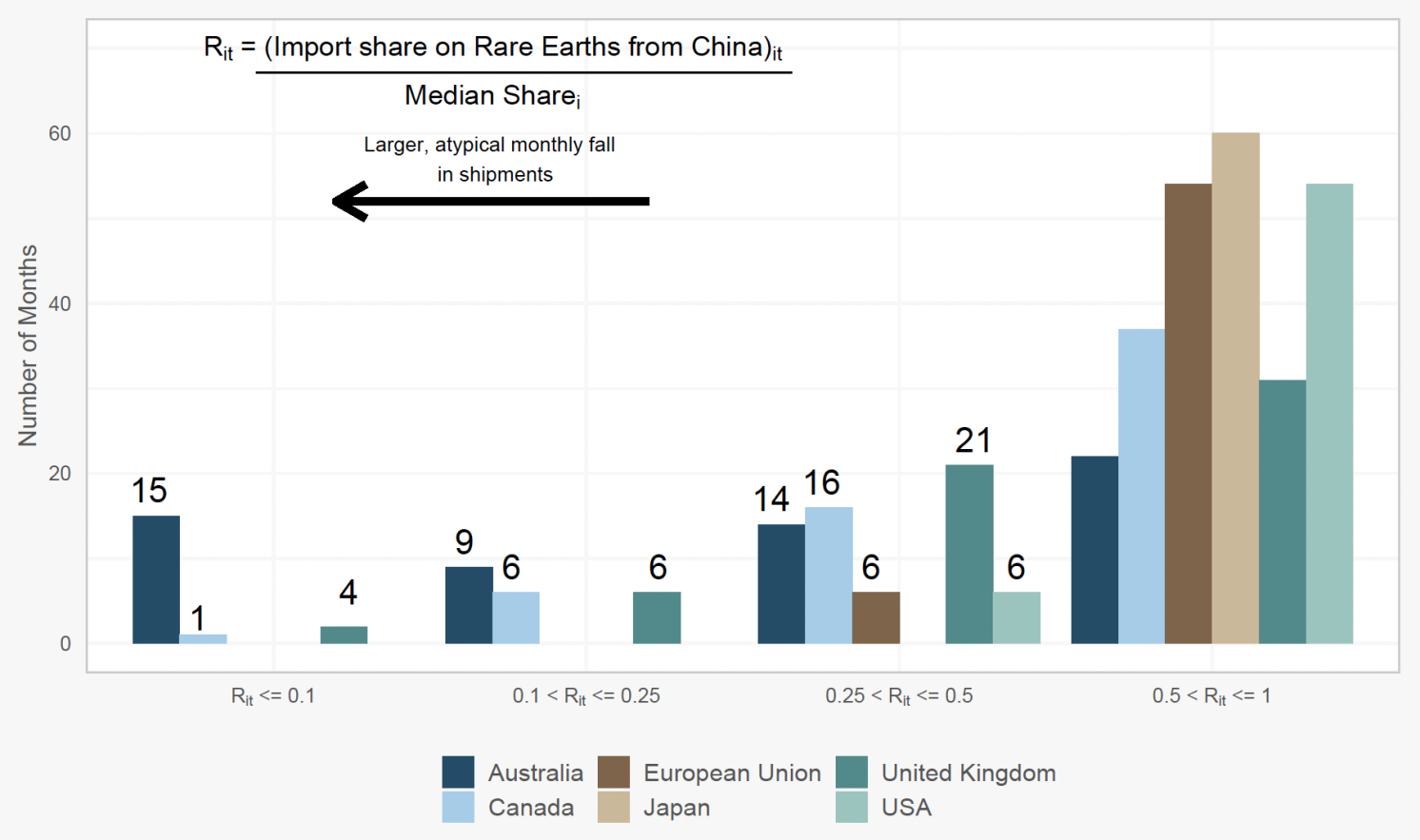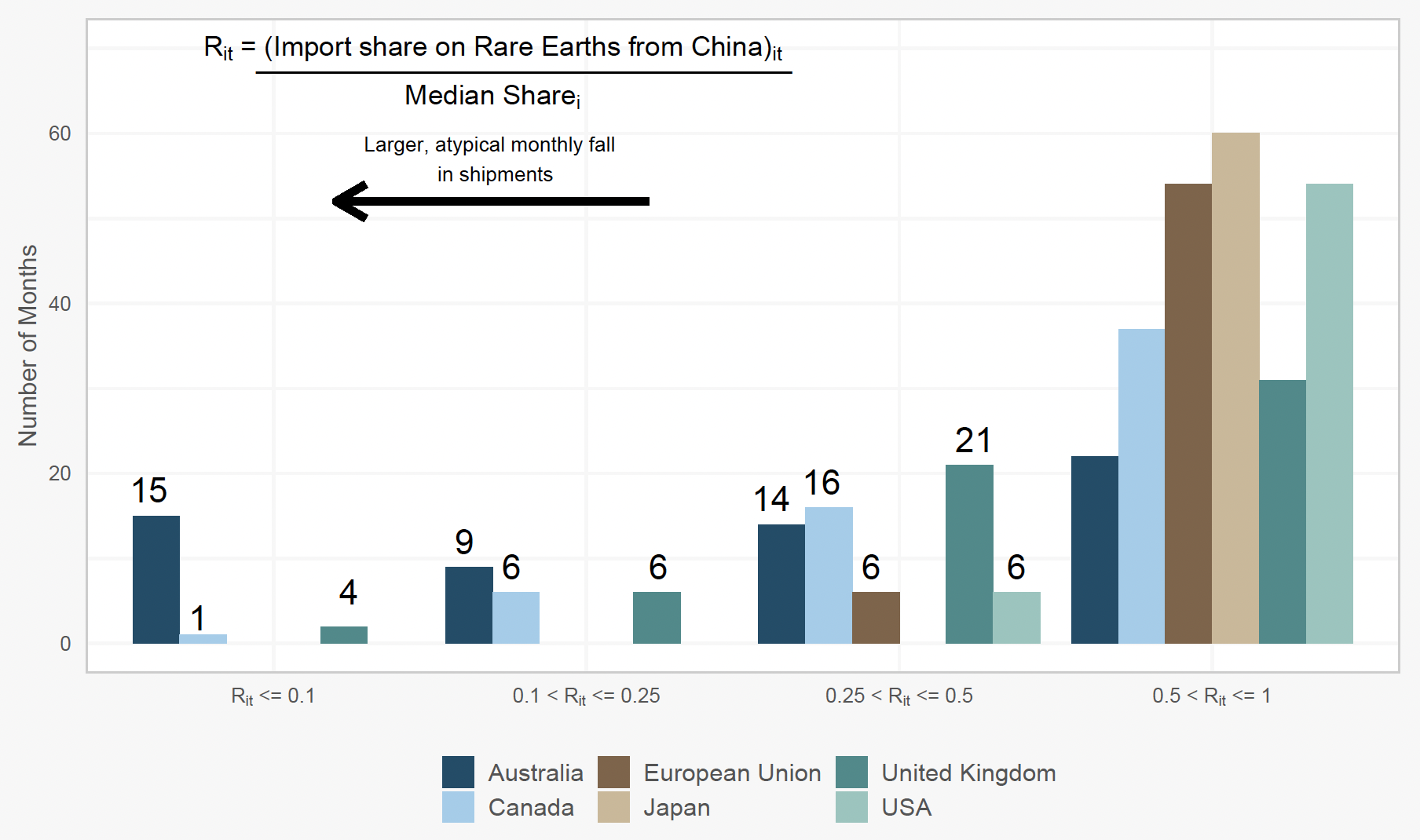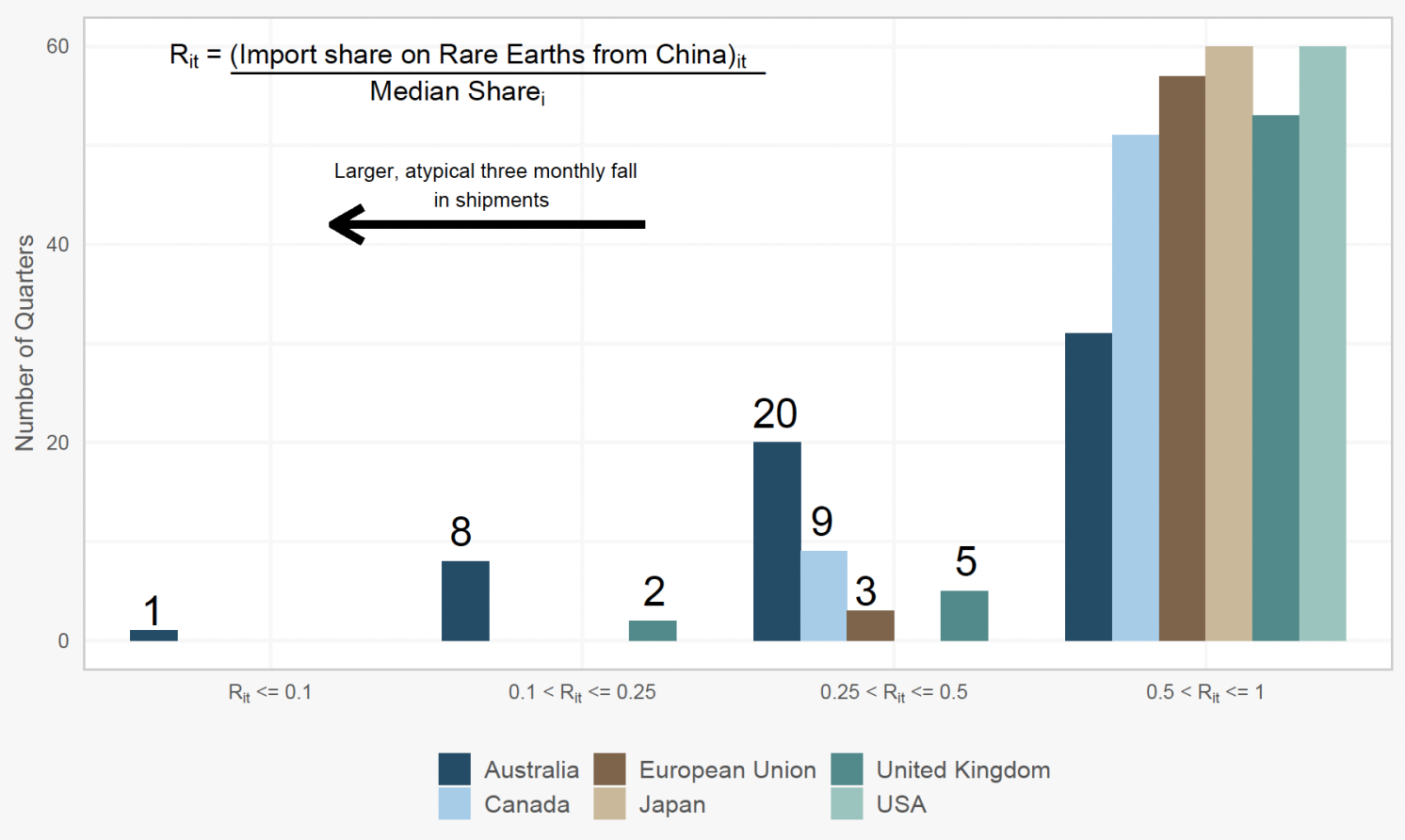The poster child for concerns about weaponising trade is China’s apparent refusal to ship Rare Earths to Japan in the third quarter of 2010. Drawing upon an analysis in the recently published Global Trade Alert report on critical raw materials, this column revisits the evidence about this salient episode. The findings highlight that in times of intensifying geopolitical rivalry, there is value in checking whether salient narratives have any basis in fact.
When pressed to provide a telling example of the geopolitical manipulation of critical raw material exports, the case of China allegedly punishing Japan in the third quarter of 2010 is invoked time and again. Twelve years on, this is still the case. For example, on 15 May 2023 the Wall Street Journal reported in a reference to the events of 2010 “China curtailed rare-earth exports to Japan after a spat over a boating collision” (Wall Street Journal 2023). Moreover, in a 13 January 2023 article on discoveries of Rare Earths in Sweden, the following points were made in a New York Times news story: “The worry is that China’s dominant position gives Beijing leverage over pricing of the metals as well as the potential to restrict supplies to rivals. In 2010, China halted exports of rare earths to Japan for two months over a fishing dispute” (New York Times 2023).
In this column, we revisit the data on this episode in 2010 to assess not only whether China’s exports of Rare Earths to Japan were disrupted but also whether similar patterns of disruption can be identified in China’s shipments of Rare Earths to the G7 members and to Australia from 2010 to 2019. The latter nation being included in our analysis because it is often claimed that they are subject to ‘economic coercion’ by China.
There is much at stake here. For if it can be shown that the factual record does not support the claim that China restricted exports of Rare Earths to Japan in 2010, and to other Western countries during the decade 2010 to 2019, then the threat of Rare Earths being cut off is hypothetical. On the other hand, if there is a track record of unusual reductions in Chinese Rare Earth exports, then this buttresses the case for thickening the markets for Rare Earths, a central recommendation of the 31st Global Trade Alert report, where a longer version of this analysis can be found (Evenett and Fritz 2023).
One matter is not in dispute as the facts were hashed out in disputes taken to the WTO: China has used export quotas and other export restrictions on Rare Earths. What is at issue here is whether the United Nations’ international trade data show that China singled out particular trading partners for sharp reductions in exports of Rare Earths. Even if we find little evidence of selective targeting of trade partners by China, there is still the legitimate concern that the announced, published export restrictions on Rare Earths implemented by China had adverse consequences for foreign buyers of those materials.
We are not alone in examining the evidence on this matter (Gros n.d.) King and Armstrong (2013), both academic analysts, make a number of pertinent factual points in a column on this matter. In addition, having analysed volume data on imports of specific Rare Earth elements into four Japanese ports, Johnston (2013) concluded: “At the very least, the data suggest that the conclusion about an embargo requires considerably more evidence than much of the media and pundit coverage has heretofore provided.”
Did China substantially reduce Rare Earth exports to Japan in the fourth quarter of 2010?
A critical detail is that, while China may have announced it would take “strong countermeasures” against Japan, it never stated publicly that it had cut exports of Rare Earths to Japan. So, analysts are left to infer whether exports of Rare Earths were reduced, were below typical levels, or were unusually low.
An oft-cited U.S. Congressional Research Service study includes a chart that purport to show a large reduction in Chinese exports of Rare Earths to Japan in October and November 2010 (Morrison and Tang 2012). The data source given for that chart is the “World Trade Atlas”. Our first goal was to reproduce this chart. We could find no international trade data source with that name. The same report, however, makes a few references elsewhere to the Global Trade Atlas database, which is a commercial database provided by S&P Global. Perhaps the authors meant this database instead?
Faced with this uncertainty, we turned to the United Nations’ COMTRADE database, which is widely recognised as the standard official source of data for international trade. Using the same four HS codes for Rare Earths in the U.S. Congressional Research Service study, we downloaded monthly data on Japanese imports of Rare Earths from China. As is best practice, we used data reported by Japan on its imports of Rare Earths from China as opposed to Chinese data on its exports to Japan.
When we look across a group of Western importers of Rare Earths, if Japan was singled out then, for the months of the embargo, we should observe that the Japanese shares of total Western imports in the months in question are below Japan’s ‘average’ share over time. One advantage of looking at the Japanese share of Western imports of Rare Earths in a given month is that all Western importers face the same prices for Rare Earths during that month. This means that if the price of each Rare Earth doubled and the quantities contracted earlier were shipped, then while the total value of recorded Japan monthly imports would double, the shares of Japanese imports in total Western imports would be, by and large, unchanged. Or at a minimum, when faced with big price changes, the share of Japanese imports in total Western imports would change less than the total value of monthly Japanese imports. In short, the signal-to-noise ratio is higher in the shares data than in the data on the total value of monthly imports.
We took as Western nations the members of the G7 nations, the European Union (treated as a single buyer), and Australia, a country said to suffer from Chinese ‘economic coercion’. For each month from January 2010 to December 2019 for which the total value of monthly import data was available, we calculated for each importer the share of total Western imports of Rare Earths in that month. Then for each Western importer, we calculated the median value of that share over our sample period. Next, we calculated the ratio of the monthly shares for an importer to its median share.
An unannounced Chinese embargo against a single trading partner should generate a ratio well below one. On this logic, examining the distribution of the values of those ratios for a given importer would reveal the number of months for which the shipments of Rare Earths from China to a destination country were unusually low. Moreover, this approach can be adapted to examine whether imports have been unusually low for consecutive months—thereby preventing rogue data for a single month resulting in erroneous inferences.
Figure 1 reports the findings from applying this methodology to identifying the number of single months where unusually low levels of imports are recorded. Notice the horizontal axis of this chart covers different ranges of ratio that fall below 1. Since, by construction, the median of the distribution of monthly outcomes occurs when this ratio is one, half of the distribution is shown in Figure 1. What matters is how much of the distribution is found towards the leftward region of Figure 1, the region that indicates unusually low levels of Rare Earth imports from China. The most striking finding in Figure 1 is that it is Australia— not Japan—that experienced many one monthly falls in Rare Earths shipments from China during 2010 to 2019. Of the 120 possible months, in 24 months the import shares received by Australia fell 75% below their average level. Interestingly, for all of the G7 members and the European Union, large monthly drops of Rare Earths shipments from China are rare.
Figure 1 Australia—not Japan—witnessed several sharp falls in Rare Earth monthly exports from China over 2010-2019


Notes: Same HS codes used to compute these statistics as in Morrison & Tang (2012). Total number of months observed: 120.
Source: UN COMTRADE.
Figure 2 is constructed in the same way as Figure 1 but for consecutive three-month intervals between 2010 and 2019. Figure 2 therefore eliminates rogue one- or two-month intervals from influencing the findings. ‘Economic coercion’ lasting three or more months, that takes the form of sharp reductions in Rare Earth exports, should be revealed in Figure 2.
Figure 2 Less than 10% of the time did Australia experience sharp falls in Rare Earths exports from China that lasted three months

Note: Same HS codes used to compute these statistics as in Morrison & Tang (2012).
Source: UN COMTRADE.
Comparing Figures 1 and 2 confirms that sustained three month drops in Rare Earth shipments occur less often than one month drops. Australia witnessed nine three-month periods where its share of Rare Earth shipments from China dropped 75% below its average level—and it should be noted that some of those nine three-month periods might overlap with one another. As there are over 100 such consecutive three-month intervals between January 2010 and December 2019, this suggests that, if manipulation of exports to Australia occurred, it happened less than 10% of the time.
Again, if there is a nation that has had to cope with erratic shipments from China, it is Australia and not Japan. Indeed, of the members of the G7 and the European Union, only the United Kingdom witnessed Rare Earths shipments from China that were 75% or more below normal levels which lasted three months. At that only happened twice.
This evidence casts doubt on the notion that China has routinely weaponised Rare Earth exports against Western nations from 2010 to 2019, arguably an era where geopolitical rivalry intensified. We do not conclude that there were no episodes of disruption to exports but, as Figure 2 shows, with the exception of Australia, very few lasted more than two months. Bear in mind, however, that during the years 2010-14, Australia sourced less than a fifth of its Rare Earth needs from China (beaten only by the UK that sourced even less over that time frame, see Table 1).
Table 1 Australia sourced little Rare Earths from China in the first place


Note: HS Codes used: 280530 (Scandium and Yttrium) 284610 (Cerium) 284690 (Lanthanum and Yttrium) 360690 (Ferrocerium and Metaldehyde).
Source: UN COMTRADE.
Narrative triumphs over facts
Notwithstanding these findings and the doubts expressed by others about the evidence, China’s alleged curtailment of Rare Earth exports to Japan has become part of folklore. Some importing governments claimed to take action to limit their exposure to Chinese Rare Earths on the basis of this narrative. Appearing to have weaponised trade may have similar consequences to actually doing it. For analysts, the important lesson here is that, in times of intensifying geopolitical rivalry, there is value in checking whether salient narratives have any basis in fact.
Source : CEPR










